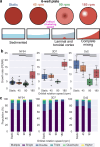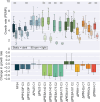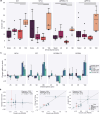Under conditions of high wall shear stress, several PfEBA and PfRH ligands are important for malaria Plasmodium falciparum blood-stage growth
- PMID: 40548744
- PMCID: PMC12345213
- DOI: 10.1128/mbio.01499-25
Under conditions of high wall shear stress, several PfEBA and PfRH ligands are important for malaria Plasmodium falciparum blood-stage growth
Abstract
Malaria kills over 600,000 people annually, with all clinical symptoms arising from blood-stage infection. Plasmodium falciparum blood-stage replication happens primarily in the blood circulation, bone marrow, and spleen, where there are flow-generated forces, yet most in vitro growth assays are carried out in static conditions. We systematically tested the effect of orbital shaking on growth and linked it to the wall shear stress forces generated by the resultant fluid motion. Strikingly, there is a critical shaking speed, below which growth rates are reduced and above which growth increases. Forces at this critical speed correspond to previously measured forces in the microvasculature. Red blood cell invasion depends on two families of parasite attachment proteins, the Plasmodium falciparum erythrocyte-binding antigen and the Plasmodium falciparum reticulocyte-binding protein. Using a panel of knockouts, we show for the first time that several of these ligands have greater importance in high wall shear stress conditions, highlighting the importance of understanding the effect of fluid motion on parasite biology.IMPORTANCEMalaria parasite growth occurs in dynamic environments like blood circulation, where fluid forces impact red blood cells and parasites. Yet, most laboratory growth assays are conducted in static environments, failing to replicate these forces. We explored the effects of growing the parasites on orbital shakers, which generate biologically relevant forces, and found that shaking speed critically impacts parasite growth, with reduced growth at speeds that mimic forces in the microvasculature. Importantly, using these conditions revealed invasion phenotypes not observed under static conditions. Understanding how fluid dynamics influence parasite growth offers a new approach to investigating malaria pathogenesis, with the potential to improve the development of therapeutic interventions.
Keywords: PfEBA; PfRH; Plasmodium falciparum; bloodstream infections; growth assay; host cell invasion; malaria; orbital shaker.
Conflict of interest statement
The authors declare no conflict of interest.
Figures





Similar articles
-
PfHDAC1 is an essential regulator of P. falciparum asexual proliferation and host cell invasion genes with a dynamic genomic occupancy responsive to artemisinin stress.mBio. 2024 Jun 12;15(6):e0237723. doi: 10.1128/mbio.02377-23. Epub 2024 May 6. mBio. 2024. PMID: 38709067 Free PMC article.
-
The Plasmodium falciparum homolog of Vps16 interacts with the core members of the Vps-C tethering complex.mSphere. 2025 Jul 29;10(7):e0028725. doi: 10.1128/msphere.00287-25. Epub 2025 Jul 8. mSphere. 2025. PMID: 40626728 Free PMC article.
-
Primaquine or other 8-aminoquinoline for reducing Plasmodium falciparum transmission.Cochrane Database Syst Rev. 2015 Feb 19;(2):CD008152. doi: 10.1002/14651858.CD008152.pub4. Cochrane Database Syst Rev. 2015. Update in: Cochrane Database Syst Rev. 2018 Feb 02;2:CD008152. doi: 10.1002/14651858.CD008152.pub5. PMID: 25693791 Free PMC article. Updated.
-
Primaquine or other 8-aminoquinoline for reducing P. falciparum transmission.Cochrane Database Syst Rev. 2014 Jun 30;(6):CD008152. doi: 10.1002/14651858.CD008152.pub3. Cochrane Database Syst Rev. 2014. Update in: Cochrane Database Syst Rev. 2015 Feb 19;(2):CD008152. doi: 10.1002/14651858.CD008152.pub4. PMID: 24979199 Free PMC article. Updated.
-
Primaquine for reducing Plasmodium falciparum transmission.Cochrane Database Syst Rev. 2012 Sep 12;(9):CD008152. doi: 10.1002/14651858.CD008152.pub2. Cochrane Database Syst Rev. 2012. Update in: Cochrane Database Syst Rev. 2014 Jun 30;(6):CD008152. doi: 10.1002/14651858.CD008152.pub3. PMID: 22972117 Updated.
References
-
- Joice R, Nilsson SK, Montgomery J, Dankwa S, Morahan B, Seydel KB, Bertuccini L, Pietro Alano CK, Duraisingh MT, Taylor TE, Milner DA. 2014. Levels and changes of HDL cholesterol and apolipoprotein A-I in relation to risk of cardiovascular events among statin-treated patients; a meta-analysis. Circulation 6:1–16. doi: 10.1126/scitranslmed.3008882.Plasmodium - DOI
MeSH terms
Substances
Grants and funding
LinkOut - more resources
Full Text Sources

